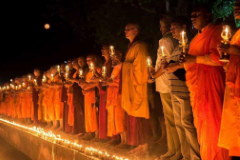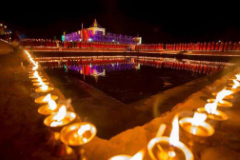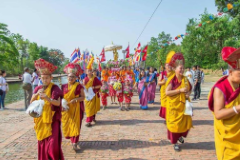The Garden of Lumbini Garden (Birth place of Buddha)

Ancient time, at Corliya nation where Queen Mayadevi was born and by Pricencess Lumbini’s one wish, the resting spot of beautiful garden was constructed between the land of Corliya nation and syaka nation.
In Lumbini Garden, the tree of Summer Camellia growing widely and colourful flowers are bloomed, honeybees are flying and endless twitters of beautiful birds are running, as if the place is the paradise of Gods.
Present time of the Lumbini Garden has developed in many ways such as afforestation project, maintenance of the waterway and advanced as the sacred garden. As Lumbini Sacred Garden had become more peaceful and quiet environment, the place became great nature home for many species and birds.
Queen Mayadevi (mother of Buddha) arrives at Lumbini

Time passes, suddordana king’s era overcome the Sakyas nation, and the king marries to Queen Mayadevi from Koliya nation. One day, Queen Mayadevi found out that she is pregnant, due to her dream she saw beautiful white elephant with 6 tusks entering her stomach. And after 10 months, Queen requested to visit heavenly forest, the Lumbini Sacred Garden.
Queen enters the Lumnini Garden, and middle of taking bathe in holy Puskarini pond, she gained labour pains. And she walks 24 steps to the North and hold on to the branch. Then while later, Lord Buddha was born.
Birth of Lord Buddha

The moment of Birth of Lord Buddha, the immense light had brimmed from the Queen’s right rib and many Gods had visited for blessing the child. 2 strings of water, warm water and cold water had appeared from heaven to purify the baby’s body.
Lord Buddha looked all directions and seven lotus flowers bloomed instantly and made his 7 steps on lotus and proclaimed, ‘I am the first and foremost of all the creatures to cross the riddle of the ocean of existence. I have come to the world to show the path of emancipation. This is my last birth, and hereafter I will not be born again’.
Then, Queen Mayadevi passed away seven days after the Lord Buddha’s birth.
Lord Buddha and Lumbini

The era when Lord Buddha was prince, there are no historical records of his activity in Lumbini. But it is obvious fact that he had certainly entered Lumbini once or more, because Lumbini was his birth place and it was also Queen Mayadevi’s memorial place.
In Lord Buddha’s history, word Lumbini appeared when Lord Buddha entered Mahaparinirvana and told one of his followers: in this land Lord Buddha was born. This land should be raised by religious and pious believers. Coming to this land, people will speak mutably and will be praised. As a result,many Buddhists visit Lumbini as Buddist sacred sites after Buddha’s death
The Lumbini after Mahaparinirvana

In 300 B.C, the Buddhism was protected by Maurya Emperor Asoka, and he himself became Buddhism and as a Buddhism pilgrim, he travelled to many sacred areas including Lumbini. Asoka constructed Asoka Pillar in Lumbini Sacred Garden. And because he had intimate relationship with India, he managed to draw a Lion on Asoka Pillar from same Lion from Indian National Emblem. Lumbini became more thrive place as Buddhism sacred location. The Stupa from 200B.C and temples wall from 300-400B.C are discovered.
Lumbini Pilgrim by Chinese Monks (form 5th to 7th centuries)

500 A.D Chinese Traveller Faxian visited Lumbini, Kapilvastu and Lama Grama while travelling to India, Sri Lanka, and Indonesia.
In700A.D,Yuan Chwong who is famous as Sanzang fashi also pilgrimed Lunbini,Kapilvastu and Ramagrama.It seems that the story of ghosts killing work in Journey to the West is not just a fairy tale,considering the difficulty of travel from China to Indea in that era.
In700A.D,Yuan Chwong who is famous as Sanzang fashi also pilgrimed Lunbini,Kapilvastu and Ramagrama.It seems that the story of ghosts killing work in Journey to the West is not just a fairy tale,considering the difficulty of travel from China to Indea in that era.
Lumbini in Modern Times (from 8th to 19th centuries)

After 800A.D the pilgrims of Buddhism had decreased as decline of Buddhism in India and Nepal. And it was until 1900A.D the hope of light came to Buddhism. In 1895, Research by German Archaeologist and Nepali General Officer, Asoka Pillar was discovered and from this moment, Lumbinis location was verified and many Archaeological researches were operated.
Lumbini in Present time (after 20th centuries)

In 1975, U Thant; the third Secretary-General of the United Nations had announced to reconstruct Lumbini , and under the United Nations the process of maintenance in Lumbini sacred Garden with the master plan made by Japanese Architecture Kenzo Tange had started. Today in Lumbini Sacred Garden, there are 22 temples and Meditation Centers constructed by 15 countries as Birth place of Lord Buddha in the center of Lumbini. And every year, 500 thousand people of pilgrims and tourist visits Lumbini in order to gain Peace and Rest.











